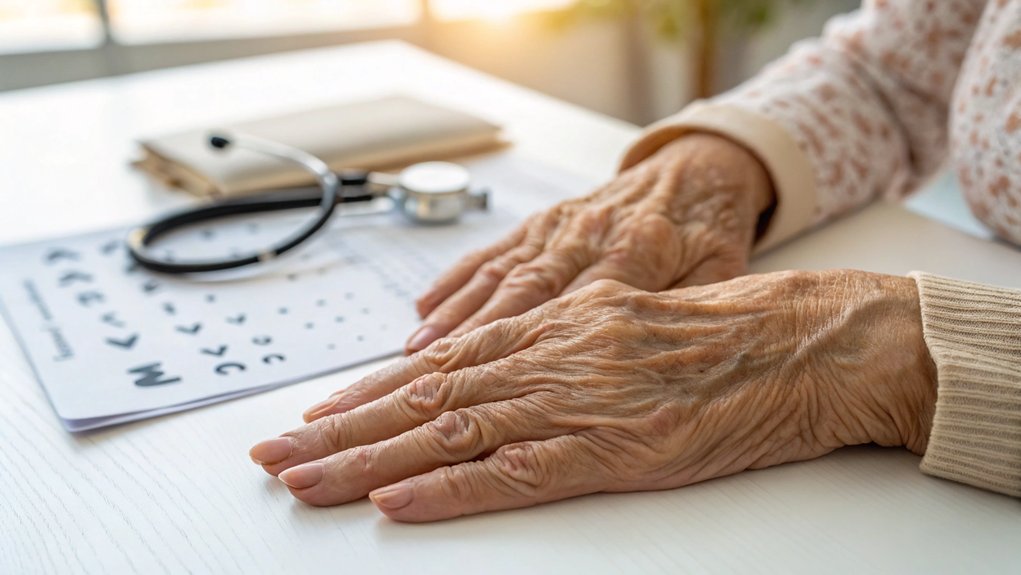Early Detection Aging Signs You Should Never Ignore

Prefer listening? Check out the podcast version of this article.
Imagine your body as a finely-tuned instrument, and you’re starting to notice it’s slightly out of tune.
Those subtle changes in skin brightness or a lack of energy aren’t just everyday nuisances; they’re signals your body is sending.

Ignoring these early signs of aging can be like letting a small leak go unchecked, eventually leading to a flood of health issues.
But how do you know which signs truly matter?
Understanding these signals can empower you to take action and maintain your well-being.
Let’s explore the signs you shouldn’t ignore.
Table of Contents
Hidden Aging Signals in Your Body
Your body can reveal hidden aging signals through subtle changes in the skin, muscles, bones, and digestive system.
Pay attention to early shifts like decreased skin elasticity, unexplained muscle weakness, or altered digestion as these can indicate underlying aging processes.
Recognizing these signs allows you to take proactive steps in maintaining your health and energy levels as you age.
Skin as Your Early Warning System
Even though it’s often overlooked, the skin serves as an essential early warning system for hidden aging signals in your body.

It’s not just about aesthetics; your skin’s condition can reveal critical information about your overall health.
Pay attention to changes like skin brightness dullness.
A decrease in brightness often signals a slowdown in cell turnover, which can be attributed to aging.
Alongside this, skin elasticity loss is another red flag.
As collagen and elastin production decline, your skin may sag, indicating deeper systemic changes.
Skin pigmentation changes, such as age spots or uneven tone, often result from sun exposure and signal cumulative cellular damage.
Discover Your Path to a Longer, Healthier Life!
Take our free quiz to see how your lifestyle measures up to the world's longest-living communities and receive expert tips for a healthier, longer life.
Take the QuizAdditionally, be mindful of skin texture irregularities, which can indicate underlying deficiencies in essential nutrients or hydration.
Skin hydration deficits not only lead to a rough and flaky appearance but also affect your skin’s barrier function, making it more susceptible to damage.
Address these signs early by consulting healthcare providers who can offer evidence-based interventions.
Regularly moisturizing, protecting against UV exposure, and maintaining a balanced diet can help mitigate these early aging signals.
Your skin isn’t just a barrier; it’s a vital communicator of your body’s health.
Silent Changes in Muscle and Bone
As you age, subtle yet significant changes occur in your musculoskeletal system that can quietly signal the onset of aging.
One of these hidden indicators is muscle mass decline, which begins as early as your 30s and accelerates over time.
This reduction in muscle mass can lead to decreased strength and endurance, affecting your daily activities and overall quality of life.
Alongside muscle changes, bone density changes also occur, increasing your risk of fractures and osteoporosis.
Joint stiffness increase is another sign you shouldn’t ignore.
It can limit your range of motion and make even simple movements challenging.
This stiffness often pairs with flexibility reduction, making it harder to maintain an active lifestyle.
Regular stretching and exercise can help counteract these effects, preserving mobility and function.
Additionally, balance impairment may become more noticeable, increasing your risk of falls and related injuries.
It’s essential to engage in balance-enhancing exercises and consult healthcare professionals to address these concerns proactively.

By recognizing these silent changes early, you can take preventive measures to maintain your musculoskeletal health, ensuring a more active and fulfilling life as you age.
Digestive and Energy Level Shifts
Beyond the musculoskeletal system, aging can quietly manifest through shifts in digestive function and energy levels, often overlooked until they significantly impact daily life.
You might notice gastrointestinal function changes, such as increased digestive sensitivity or appetite regulation shifts.
These changes could signal a metabolic slowdown, affecting how your body processes food and manages energy.
| Symptom | Possible Cause | Recommended Action |
|---|---|---|
| Digestive Sensitivity | Gastrointestinal function changes | Monitor diet; consult physician |
| Energy Fluctuations | Energy fluctuation patterns | Regular exercise; balanced diet |
| Appetite Changes | Appetite regulation shifts | Nutritional counseling |
Energy fluctuation patterns often accompany aging, with some experiencing drastic highs and lows.
A consistent decline in energy might hint at underlying metabolic slowdown signals.
Addressing these energy shifts early through lifestyle modifications, like regular physical activity and a nutrient-rich diet, can mitigate fatigue and improve overall vitality.
It’s crucial to be attentive to these subtle signs.
If you notice persistent changes, seeking medical advice can help pinpoint the cause.
Early detection allows for tailored interventions, potentially slowing down or reversing unwanted aging effects.
By staying vigilant, you can maintain a higher quality of life as you age gracefully.
Brain and Memory Red Flags
You should pay close attention to any daily task difficulties, as these can indicate early cognitive changes.
Noticeable social and communication changes, such as withdrawing from conversations or struggling to find the right words, are also important red flags.
Additionally, watch for memory patterns like frequently misplacing items or forgetting recent events, as these may signal the need for further evaluation.
Daily Task Difficulties That Matter
Many individuals experience subtle memory lapses that could signal more significant cognitive concerns.
One of the earliest indicators is the need for daily routine modifications.

You might find yourself struggling with household tasks that once seemed simple, such as managing finances or preparing meals.
These household task struggles can be frustrating and may require you to adopt new strategies or seek assistance.
At work, you could notice difficulties in navigating work changes.
Tasks that demand problem-solving or adapting to new technologies might become more challenging.
This can impact your productivity and confidence, prompting you to reassess your role or responsibilities.
Furthermore, changes in your engagement with hobbies and interests can also be telling.
If you’re losing interest in activities you once enjoyed, or finding them harder to follow, it could be a red flag.
This shift may lead to social circle adaptations, as your participation in social activities declines, possibly affecting your relationships.
It’s crucial to recognize these signs early.
Addressing them with professional guidance can help maintain cognitive health and quality of life.
Don’t ignore these challenges; they matter in understanding and managing your cognitive health effectively.
Social and Communication Changes
Recognizing daily task difficulties is just one aspect of cognitive health; social and communication changes offer additional insights into potential brain and memory issues.
It’s important to observe social isolation signs, as they can indicate early cognitive decline.
If you notice a loved one withdrawing from activities they once enjoyed, it might be a red flag.
Reduced social engagement often accompanies cognitive challenges, making it crucial to address these changes early.
Communication breakdown patterns are another significant concern.
When someone struggles to follow conversations or frequently loses track of discussions, it can signal underlying issues.
Similarly, diminished empathy can manifest as an inability to understand or respond to others’ emotions, affecting relationships.

Memory Patterns to Watch
Several memory patterns can serve as red flags for potential brain and cognitive issues.
It’s important to pay attention to memory recall trends, especially if you notice increasing difficulty in remembering recent events or conversations.
Such changes might indicate underlying cognitive processing changes.
If you’re experiencing verbal fluency shifts, like struggling to find the right words or frequently pausing mid-sentence, this could be an early warning sign.
Concentration difficulties, including trouble staying focused on tasks or following conversations, shouldn’t be ignored.
These issues might signal more than just normal aging and could require further evaluation.
Multitasking challenges, such as feeling overwhelmed by tasks that once seemed simple, can highlight shifts in cognitive capacity.
Recognizing these patterns early allows for timely intervention.
Consulting a healthcare professional for an assessment can help determine if these symptoms are part of normal aging or if they indicate a condition that needs attention.
Early identification and management can make a significant difference in maintaining your cognitive health.
Don’t hesitate to act if you notice these signs, as proactive measures can improve your overall quality of life and cognitive function.
Medical Tests That Reveal Your True Age
To accurately gauge your true biological age, certain medical tests can provide valuable insights.
Blood tests assessing essential markers, such as inflammatory proteins and lipid profiles, coupled with hormone level indicators like cortisol and testosterone, offer a comprehensive view of your aging process.
Additionally, physical performance measurements, including grip strength and walking speed, can further evaluate how well your body is aging compared to your chronological age.
Essential Blood Markers
While aging is inevitable, understanding your true biological age can empower you to take control of your health.
Essential blood markers provide a glimpse into the aging processes at the cellular level.
Monitoring inflammatory markers can reveal chronic inflammation, a key factor in accelerated aging and age-related diseases.

High levels of these markers suggest the need for lifestyle modifications to bolster your health.
Your immune system status is another critical component.
Blood tests can measure immune cell function, indicating whether your body’s defense mechanisms are robust or declining with age.
A compromised immune system can make you more susceptible to infections and other health issues, signaling the need for proactive interventions.
Mitochondrial health is fundamental to your energy production and overall vitality.
Blood tests can assess mitochondrial function, helping identify potential energy deficits that mightn’t align with your chronological age.
Examining cellular senescence through blood analysis offers insights into how well your cells are aging.
Senescent cells can contribute to tissue dysfunction, so identifying them early allows for targeted strategies to rejuvenate cellular health.
Lastly, epigenetic changes observed in blood tests can reflect how lifestyle and environmental factors are influencing your genes, offering actionable insights into personalized aging interventions.
Hormone Level Indicators
Understanding the intricate processes of aging goes beyond cellular markers; hormone levels offer profound insights into your body’s aging trajectory.
Hormone imbalances often serve as early indicators of aging, influencing various bodily functions.
Monitoring these levels can provide valuable information on how well your body is aging and help you take proactive steps.
Thyroid function changes are common as you age, affecting metabolism, energy levels, and overall wellbeing.
If you notice fatigue, weight gain, or temperature sensitivity, it might indicate a shift in your thyroid hormones.
Sex hormone fluctuations, such as decreases in estrogen or testosterone, can impact bone density, muscle mass, and mood.
Early detection of these changes allows for timely intervention to maintain health and vitality.
Adrenal gland shifts, often seen as a response to chronic stress, can lead to fatigue and decreased resilience.
Monitoring cortisol levels helps in understanding how well your body adapts to stress over time.
Insulin resistance indications, such as increased blood sugar levels, can signal metabolic aging and a higher risk of conditions like diabetes.
Regular testing and lifestyle adjustments can mitigate these risks, promoting healthier aging.
Physical Performance Measurements
Physical performance measurements offer crucial insights into your true biological age, often revealing more than just how old you’re on paper.
By assessing various physical capacities, you can identify early signs of aging that mightn’t yet be visible.
Muscle endurance tests, such as timed planks or wall sits, evaluate how long your muscles can sustain activity, reflecting muscle health and stamina.
Lifespan Comparison Tool
Compare the life expectancy by the U.S. State
Balance assessment methods, like the one-leg stand test, provide valuable information about your stability and coordination, which tend to decline with age.
Poor balance can increase fall risk, so addressing it early is essential.
Flexibility evaluation techniques, involving stretches to gauge joint range of motion, can highlight decreases in mobility often linked with aging.
Aerobic capacity measurements, such as VO2 max tests, assess your cardiovascular efficiency and endurance.
A decline here could indicate reduced heart and lung health.
Monitoring your progress through strength training progressions helps you understand changes in muscular strength, which is crucial for maintaining independence as you age.
Taking Action Against Early Aging
You can take actionable steps against early aging by implementing targeted solutions for each warning sign and making lifestyle adjustments that have been proven effective.
Regular physical activity, a balanced diet, and stress management play a critical role in slowing down aging processes.
If you notice persistent changes in your physical or cognitive health, it’s important to seek professional help to tailor a plan that best addresses your specific needs.
Targeted Solutions for Each Warning Sign
Recognizing early signs of aging is pivotal, as it empowers you to implement targeted solutions that can significantly impact your long-term health and wellbeing.

When you notice posture changes and muscle tone shifts, consider incorporating strength training exercises into your routine.
These exercises help maintain muscle mass and improve posture, addressing both concerns simultaneously.
Skin laxity patterns, such as sagging and reduced firmness, can be managed with topical treatments rich in retinoids and peptides, which promote collagen production and enhance skin elasticity.
Joint stiffness dynamics often manifest as decreased mobility and discomfort.
Engaging in low-impact exercises like swimming or yoga can improve joint flexibility and reduce stiffness.
Additionally, maintaining a healthy weight alleviates unnecessary stress on joints, further enhancing mobility.
Balance and stability concerns can be addressed by incorporating balance exercises, such as tai chi or simple balance drills, into your daily routine.
These activities enhance proprioception and reduce fall risk, crucial for maintaining independence as you age.
Lifestyle Adjustments That Work
When seeking to take action against early signs of aging, incorporating evidence-based lifestyle adjustments can significantly enhance your overall well-being.
Prioritizing sleep quality improvements can rejuvenate your body’s repair mechanisms, optimize cognitive function, and boost mood.
Aim for 7-9 hours of uninterrupted sleep by maintaining a consistent bedtime routine and minimizing screen time before bed.
Diet nutrient balancing is crucial.
Focus on consuming a variety of fruits, vegetables, lean proteins, and healthy fats to supply essential vitamins and minerals.
This approach supports cellular health and combats oxidative stress, a key factor in aging.
Implement stress reduction techniques such as mindfulness, meditation, or yoga to decrease cortisol levels, which accelerates aging.
These practices enhance mental clarity and emotional resilience, improving your quality of life.
Weight management strategies are vital for reducing the risk of age-related diseases.
Monitor your caloric intake and engage in regular physical activities to maintain a healthy weight.
Exercise routines optimization is another effective strategy.
Engage in a mix of aerobic exercises, strength training, and flexibility workouts to preserve muscle mass, improve bone density, and enhance cardiovascular health.
Tailoring these routines to your needs ensures maximum benefits in combating early aging signs.
When to Seek Professional Help
Although the aging process is natural, there are times when seeking professional help becomes essential to effectively manage early signs of aging.
Recognizing when to take action can’t only enhance your quality of life but also delay more serious conditions.
- Cognitive Assessments: If you’re experiencing memory lapses or difficulty with familiar tasks, it’s wise to undergo cognitive assessments. Early detection of cognitive decline can lead to timely interventions.
- Sleep Quality Concerns: Persistent sleep disturbances shouldn’t be ignored. A healthcare provider can help determine underlying causes and recommend solutions to improve your sleep quality, which is vital for overall health.
- Emotional Well Being Indicators: Changes in mood or persistent feelings of sadness could indicate more than just aging. Seeking guidance from a mental health professional can support your emotional well-being.
- Mobility Evaluations: If you notice changes in your mobility or balance, it’s important to have a mobility evaluation. Early intervention can prevent falls and maintain independence.
Additionally, a thorough family history review with your healthcare provider can identify potential genetic risks, guiding personalized preventative strategies.
Taking these steps empowers you to manage aging proactively.
Conclusion
As you navigate the journey of aging, don’t ignore the subtle signs your body sends, like a telegram from a bygone era.
Recognizing these signals—be it skin changes, cognitive shifts, or energy dips—allows you to take charge of your health.
By consulting with healthcare professionals and undergoing key medical tests, you can craft a proactive plan to maintain your vitality.
Remember, early detection is your ally in sustaining wellbeing and enjoying life to its fullest.

 972-393-1699
972-393-1699





